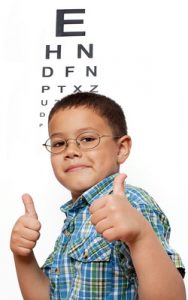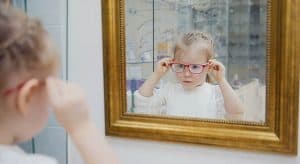These are the 5 most frequent questions asked to eye doctors on children’s vision.
You may easily find answers to your questions below. If you still have questions, contact your nearest eye doctor experienced in children’s vision.
Over 2.5 billion children have vision problems, yet 80% of those are preventable.
A comprehensive eye exam will assess not only a child’s vision, but can also detect problems with their eye health and general health.
Schedule an appointment with an eye doctor near you for a comprehensive eye exam to ensure your child has healthy vision and to check for eye diseases and other health problems.
SEE RELATED: Does your Child have a Learning Difficulty?
Here are some frequently asked questions related to pediatric eye health:
1. How regularly should children visit an eye doctor?
The American Optometric Association and the American Public Health Association recommend that children have their first eye exam at 6-12 months of age.
After their first eye exam your optometrist will let you know when their next exam is due. At a minimum, they should return for an eye exam every 1-2 years.
Once a child starts school, they should have a comprehensive eye exam once a year, or as recommended by their eye doctor.
2. Is a school vision screening sufficient for my child?
No.
School vision screenings are insufficient since they are only intended to detect a few vision problems, such as myopia (nearsightedness).
A thorough eye exam, on the other hand, allows an eye doctor to evaluate a child’s vision and eye health, as well as visual skills like focusing and eye tracking. Since a child’s visual skills are important to their academic success, eye doctors suggest that children have a comprehensive eye exam before starting school and every year after that.
Schedule an appointment with an eye doctor near you to have your child’s vision checked.
3. How does vision play a role when children are diagnosed as dyslexic or learning disabled?
Not every child who has been diagnosed with a learning disability and/or ADHD actually has one or both of these conditions.
Undiagnosed vision problems sometimes present with the same signs and symptoms as dyslexia and attention disorders.
Of course, children with dyslexia, ADHD, and other conditions can experience vision problems at the same time. When children’s vision issues are addressed, they also find it easier to learn.
It is estimated that 25% of school-aged children have an undiagnosed vision problem that could interfere with learning.
4. At what age can a child wear contact lenses?
There is no set age when a child may begin wearing contact lenses. In fact, 4 million children under the age of 18 in the United States wear contacts.
Contact lenses are particularly well suited for children after the age of 8 years.
Many children love wearing contacts especially for active or sports-loving children, and they are an excellent treatment choice for children with myopia.
They may be prescribed for children as young as six months old due to congenital cataracts or other infant eye disorders.
5. My child keeps breaking their glasses. Are there effective long-lasting glasses for children?
There is a wide selection of frames for children that are specifically built to be flexible and withstand a sufficient amount of mechanical stress.
Some children, on the other hand, can manage to break, bend, or damage their glasses, that is why having a spare pair of glasses is advised.
Early vision care can help your child reach their full learning potential.
LEARN MORE: Vision for School
Schedule an eye exam with an eye doctor near you to ensure your child’s vision remains clear and healthy.









